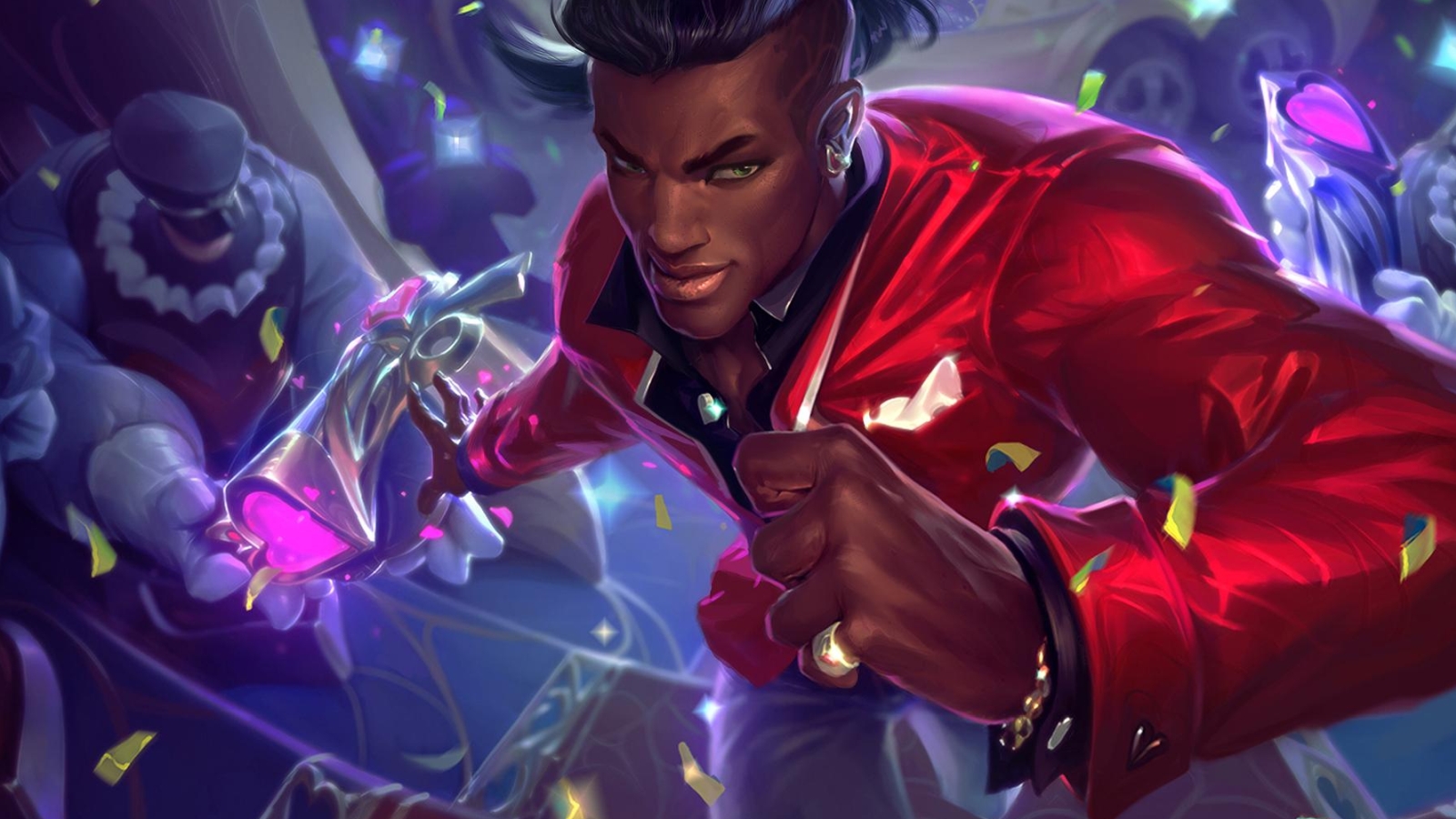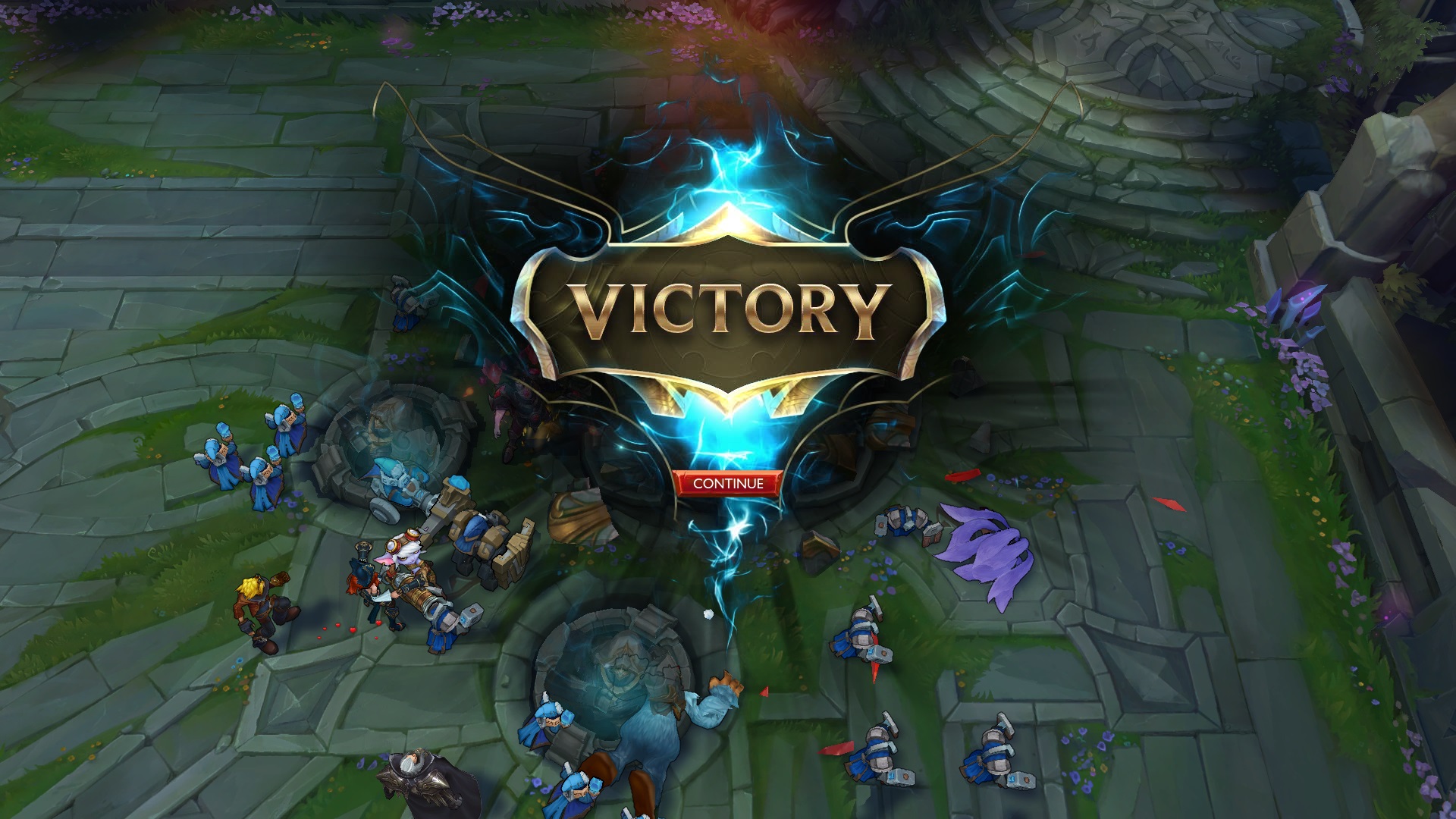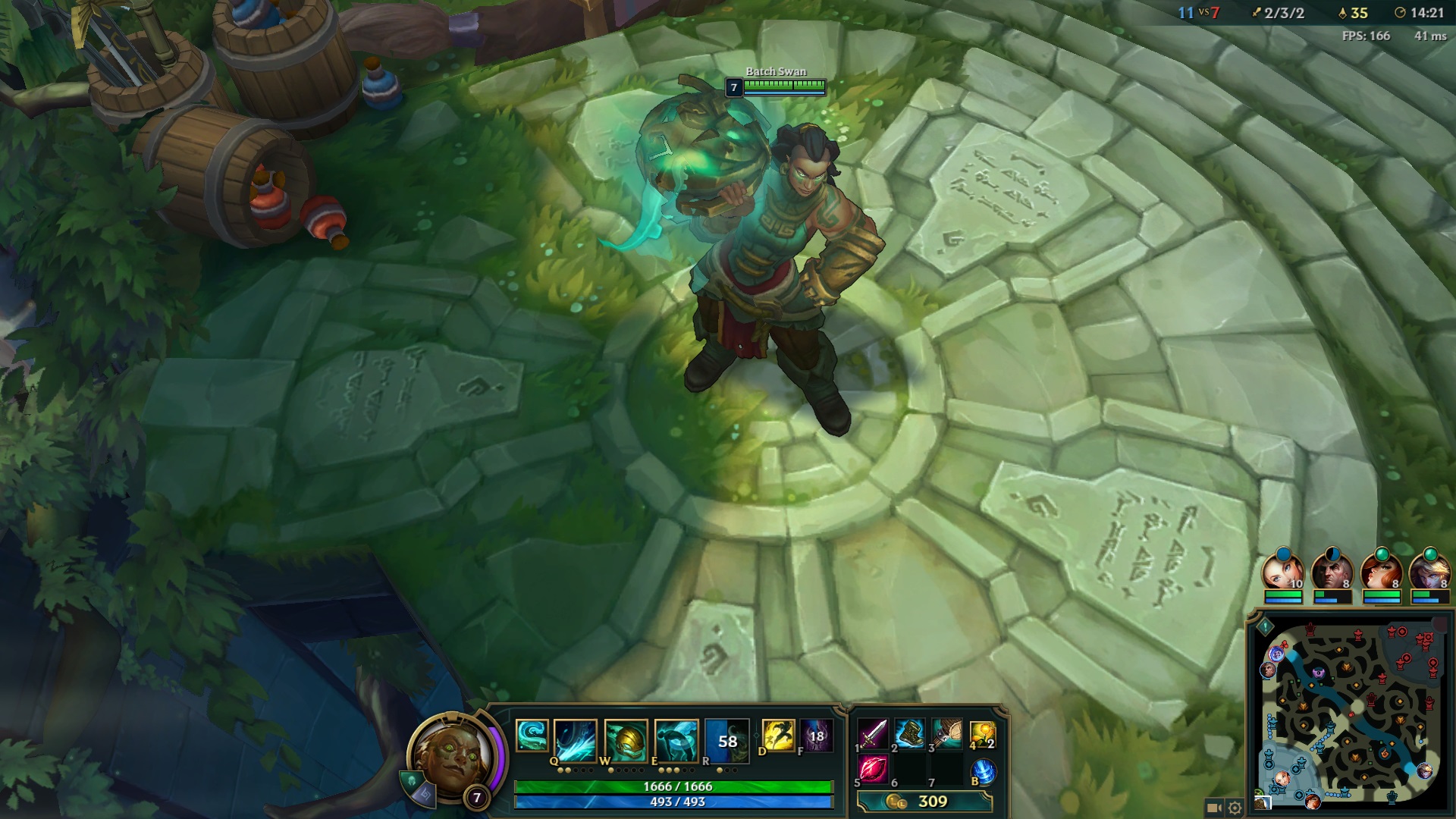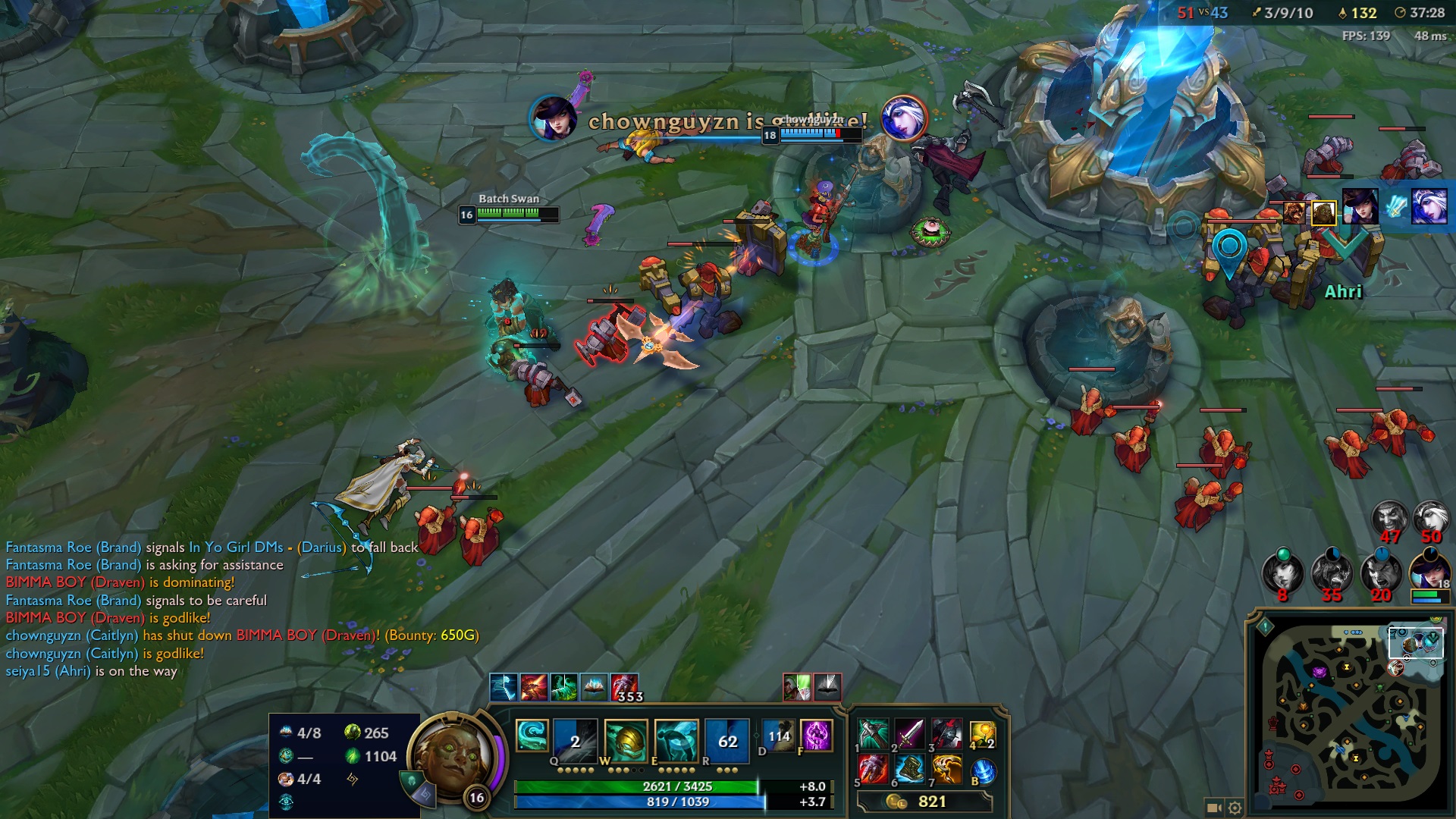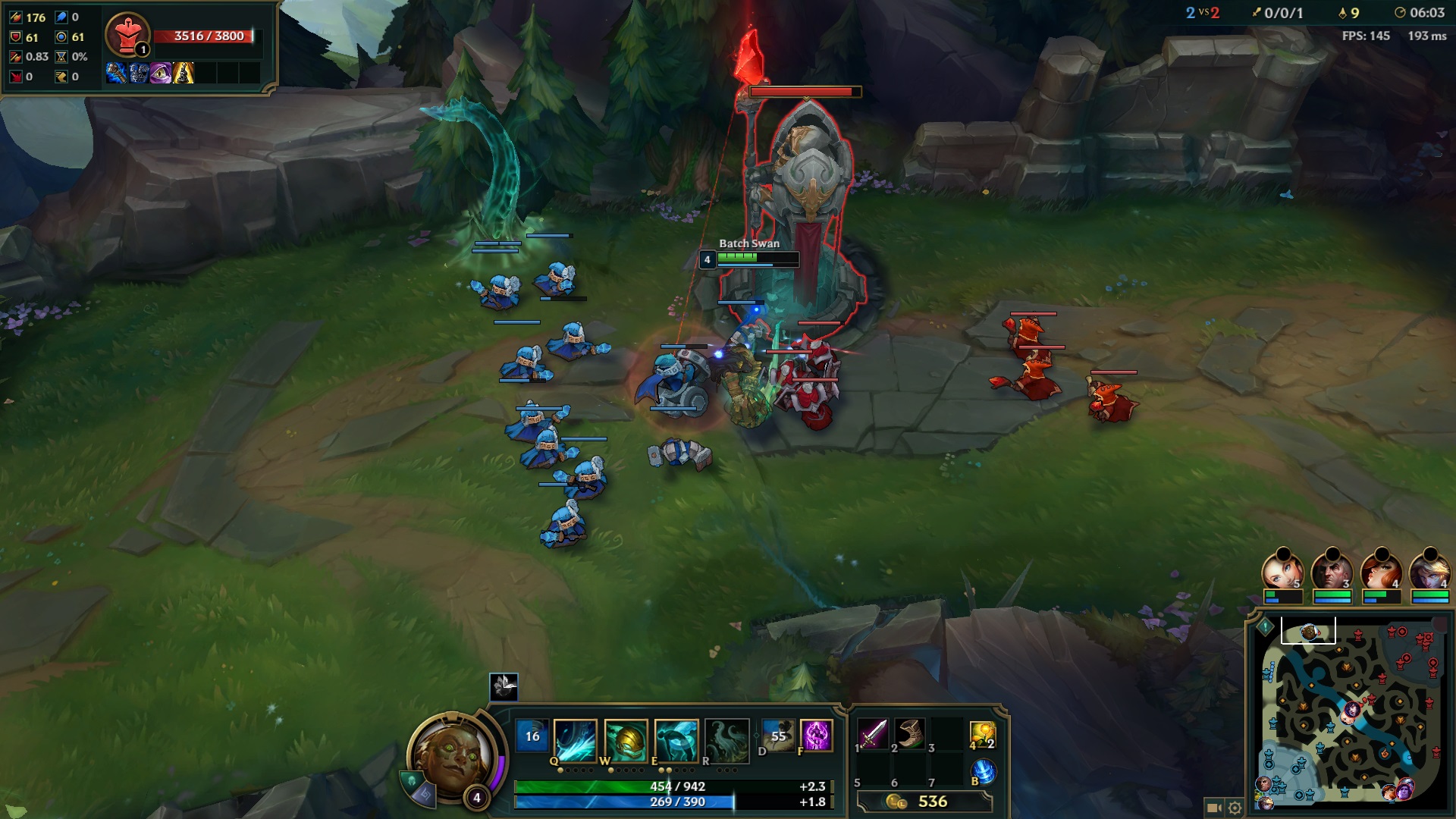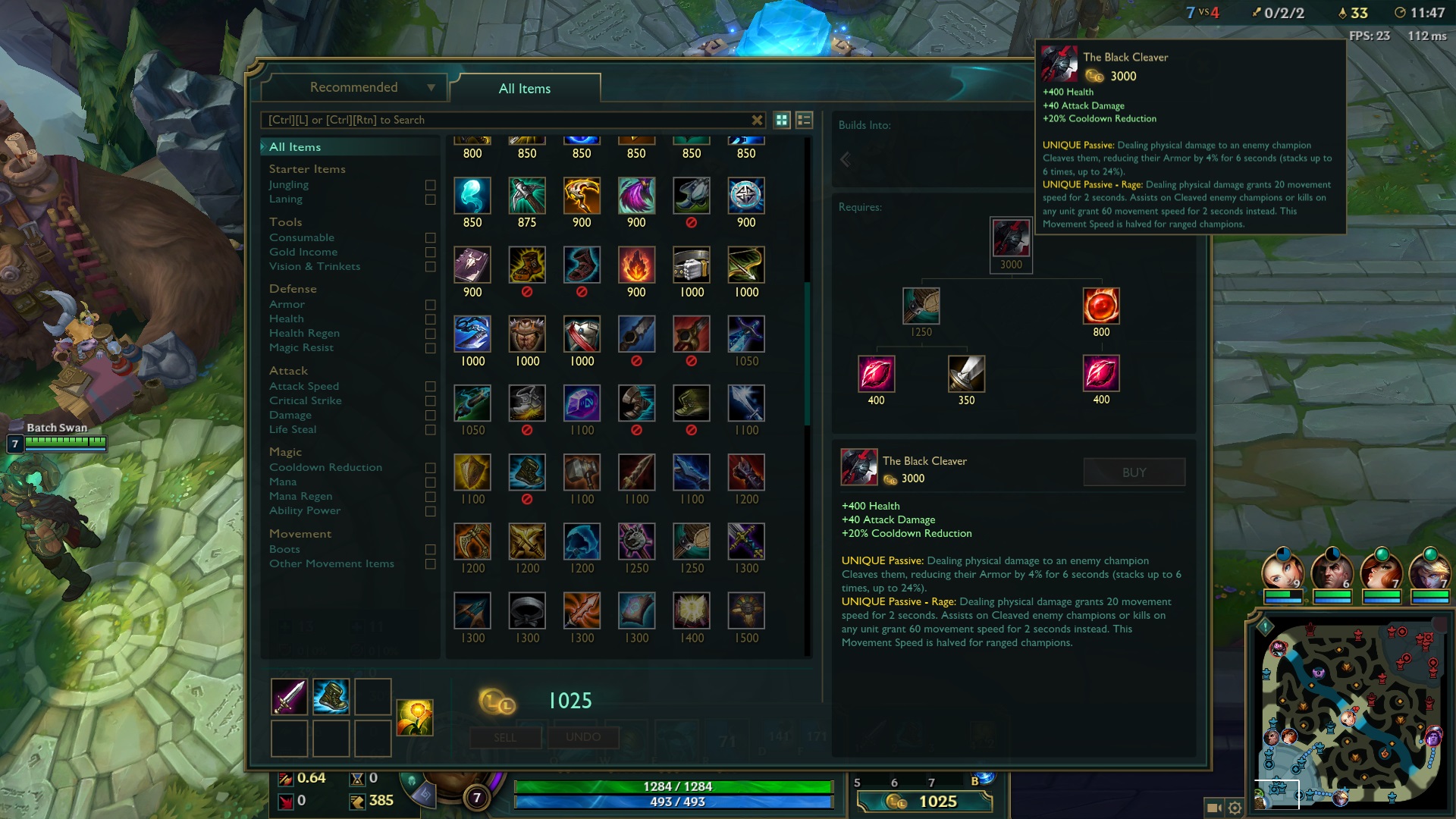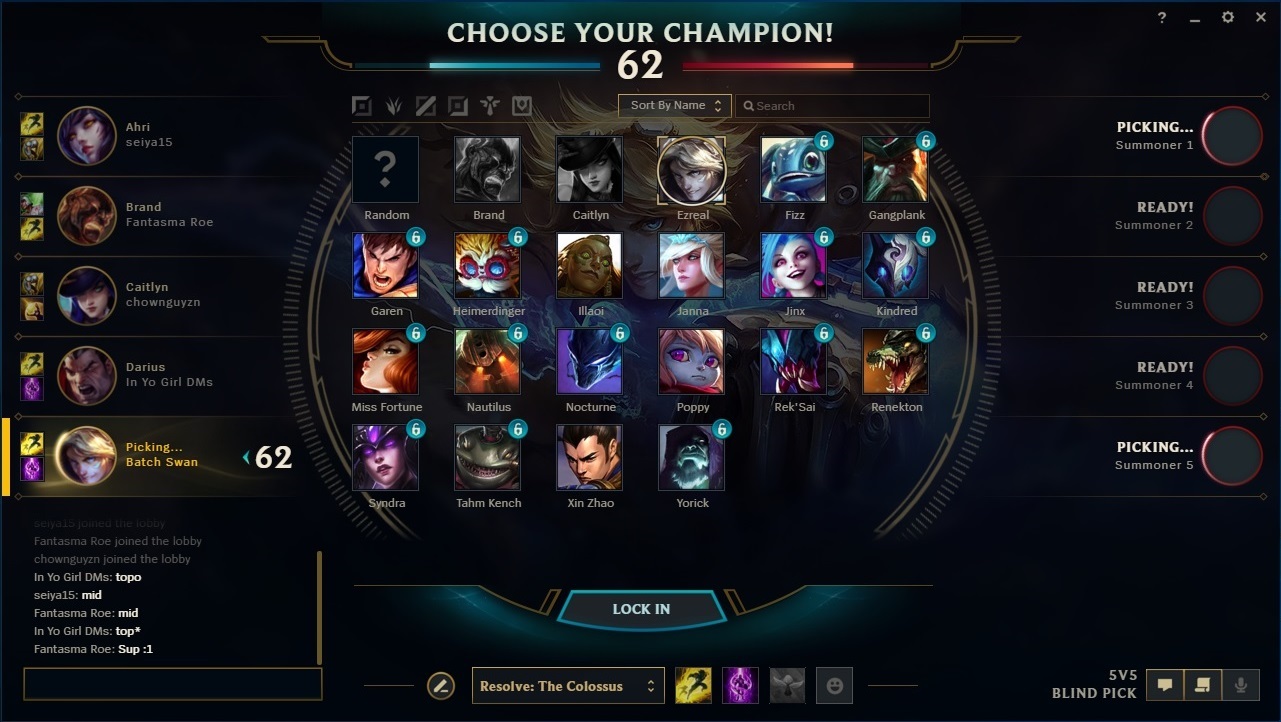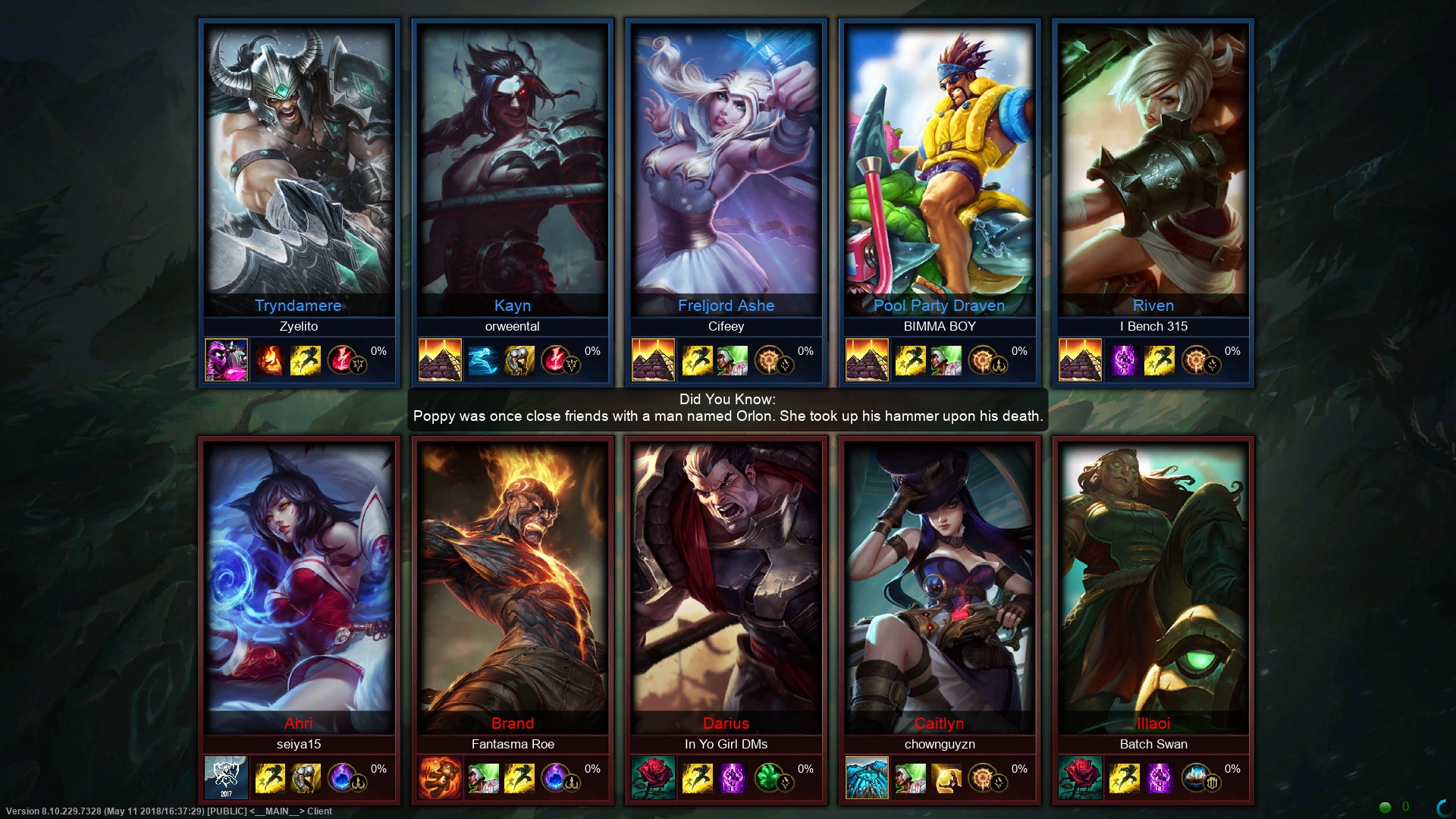Our Verdict
LoL has improved in some ways more than others over the past eight years, but it remains one of the best strategic duelers.
PC Gamer's got your back
We originally reviewed League of Legends in 2009, when it first released. It has changed significantly since then, so much so that we decided to review it again. For more about why we've chosen to re-review certain games, head here.
What is it? A multiplayer action RPG-style team battler that took inspiration from Warcraft 3 mod Defense of the Ancients.
Price: Free with microtransactions
Release date: Out now
Publisher: Riot Games
Developer: Riot Games
Multiplayer: Online, up to 10 players on teams of three or six, with five-player co-op against bots
Link: Official site
I'm a friendly, murderous fish-boy and I'm in danger. I've been bullied out of position by Caitlyn, a sniper in tacky steampunk attire, and forced to skulk in some nearby brush. She knows I’m there. She simply can’t see me without entering the shrubbery as well—nullifying her range advantage and allowing me to close in with my Aquaman-esque trident. So instead, the Caitlyn player takes a potshot into the area with a skill that damages in a straight line; no targeting required.
It's enough to kill my weakened champion Fizz in one hit. It's also just what I've been waiting for. Fizz can pogo hop onto his trident, making him immune to such directed attacks, and leap forward in a damaging slam. I use the momentum to dodge Caitlyn’s blast and close the distance she wanted to maintain. One lunging strike later, the bully is dead in the dirt, and a bounty of gold and experience points only prepares me further for the next fight.
These kinds of tense one-on-one, do-or-die battles happen in every League of Legends match, but the adrenaline in these moments makes each of them memorable. League is a lens that amplifies every emotion on the spectrum.
Desperate struggles
Every match is like an entire multiplayer action-RPG condensed into 20-to-50 minutes. Each player starts with nothing but command of a single unit and one special skill. They're split into two opposing teams of five and let loose against each other over a top-down battlefield. Smiting enemy units in real time earns gold and experience, which grant access to increasingly powerful skills and a choice of better gear. The team that wins is the team that best leverages its units’ particular strengths.
Your ultimate objective is to destroy the opposing team's headquarters. The fighting mostly occurs across three roads leading to each “Nexus.” Each path is defended by AI sentinels and human players desperate to justify their use of free time.
I don’t blame them. I also want my in-game announcer to shout “victory” and justify the stress and precious life span I spent demolishing virtual towers and warriors. I want to feel like getting flanked and killed five times in the first half hour was worth it for the last-minute push into enemy territory that cinches the win—all because I had the foresight to pick a late-game champion designed to come back from behind. The emotional investment in those strategic gambles is heightened by the length of the matches, elevating the high of victory, while making every low feel that much lower. It’s a recipe for friends and perfect strangers to turn their frustration on each other, adding a personal layer to every vexing loss.
Keep up to date with the most important stories and the best deals, as picked by the PC Gamer team.
League of Legends’ pay-per-character business model pushes against mastering the game and understanding how its champions play.
Every match you re-dedicate yourself to playing an important role on a team, like tank or support, trying to accrue experience, money and lucrative player kills faster than the other team. But the real investment in League of Legends extends far beyond that. There are 140 playable characters and rising. Each has multiple skills that work in tandem or counter another. That's not even including passives from mix-and-match runes, or spells that can be equipped before a match begins.Between the sheer scale of variables at play, and League's well-documented toxicity (even the game's own developers aren't immune to it), it's one of the most daunting games in history.
League does little to relieve any of that pressure. Encouraging millions of players to be civil is a tough, likely Sisyphean task, but easing players into League's complexity should be more attainable eight years after release. Like other similar games, League of Legends does an alright job of explaining the most basic of basics. This is how you select a champion. This is how you buy them a nice pair of shoes. That sort of thing. Where it flounders, or hardly even tries to help at all, is in explaining when and why you should apply those basics to a given situation.
League of Legends' pay-per-character business model pushes against mastering the game and understanding how its champions play. It'll take you several years of grinding, the better part of a thousand dollars, or a mix of the two to unlock the whole roster permanently. There’s a weekly rotation of free characters, too, but none of these options compare to on-the-job training. If I get crushed by Ryze, for instance, I can pore over his kit outside the game, but nothing is a true stand-in for knowing how he handles under my own index finger.
This free-to-play model is still a major impediment to LoL's accessibility—not to mention its 'purity' as an esports phenomenon—and some odd UI choices don't help, either. You can't examine a champion’s abilities from the select screen, for instance. That means you either need to learn on the fly or already know what a character is capable of. Likewise, you can't peruse an opposing player's skills mid-match.
Floors and ceilings
But if you work past the aggressive team chat and devote an entire lobe of your brain to memorizing movement speed and cooldown timers, League's high highs take back quite a lot of lost ground. I've developed the patience to only launch Brand's fiery, bouncing death-ball when it's guaranteed to ricochet off every enemy champion. I know to sneak behind enemies before they retreat, sandwiching them in flanking maneuvers on pure instinct.
At its best, League of Legends is competitive, high-speed math. Keeping your attack damage carry, the team member tasked with pumping out consistent damage in big team fights, in one of three lanes to soak up gold and experience points might just give you the greater sum. Then again, maybe moving them around to land the lucrative killing blow on squishy, defenseless supports is the way to go.
At its best, League of Legends is competitive, high-speed math.
It's an addictive game of cat and mouse that makes me feel like a criminal mastermind. Success isn't just a prefabricated plan coming together. The knowledge that live human beings are behind the monitor, devising their own schemes to stop me, means that I've well and truly outplayed people of ostensibly similar skill.
And thanks to League's comparatively quick action—just slightly twitchier than Dota 2's yawning chess matches and a hair longer than Heroes of the Storm’s intentionally accessible skirmishes—there's a sense of physical mastery, too. One of the strongest stuns in Dota, for example, lasts for a maximum of five seconds. An extremely similar skill in League of Legends tops out at about two-thirds of that. So when I’m too panicked to step out of the way of Ashe’s knockout strike in League (every single time), I'm back to exchanging magic missiles that much faster. If I live.
As matches progress, items bought with hard-won gold make player-versus-player fights even more common and ferocious. The Black Cleaver, a vital in-game item for Illaoi, one of my favorite champions, provides a nice cushion of health and some attack power. Perhaps more vitally, the chopper also cools down its wielder's abilities significantly faster. So do many other items.
The resulting shorter time between spell casting increases the pace of battle without removing the focus from predetermined character skills. I know Illaoi summons ghostly tentacles with her passive ability. Her four active skills order them to pancake my enemies. Items like the Black Cleaver just call the tendrils to my aid faster, and let Illaoi hit harder in between. They rarely ask me to remember more than her basic spells.
So while getting into League requires a ton of memorization, mastering it is more about finesse. Every player starts every match with limited tools. The wiggle room for outdoing opponents is mostly found in reaction time and precision. Or maybe you are playing just as well as your opponents, but losing anyway. Maybe you just so happened to draft someone who is numerically weaker than your counterpart on the opposite team. That's where 'game sense' and reflexes end, and the meta begins.
The cool kids club
Another super-powered tactic might have already taken root by the time you’re reading this.
You might wonder how even a company as well-staffed and buried in cosmetic skin money as Riot Games can keep 140 champions (and counting) balanced. The answer is it doesn't. There's usually a fairly tight list of the cream of the crop amid a sea of unloved nobodies. It's just not always the same clique of popular kids month to month.
That shifting assortment of S-tier picks, bans, and character builds is called the meta, and I've always understood League's to be just a little bit narrow. When a given strategy works, it tends to work extremely well, and the upper echelons of competitive play cling to it for dear life.
In 2017, it was the insufferable tank meta. Immortal abominations like Dr. Mundo and Maokai spent this era whomping each other with all the intensity of a Nerf war while dragging every game out to twice its natural length. More recently, long-range, crit-focused marksmen were the juiciest picks.
Another super-powered tactic might have already taken root by the time you're reading this. Twice monthly patches make small but meaningful changes to the math behind the mayhem. Each such adjustment nudges optimal champion choices in one direction or another, but there's basically never a completely level playing field.
It's a roll of the dice in more ways than one. There's always a chance the numbers will tell you to pick a particular support or tank that just doesn’t strike your fancy. That's a fact of life in any competitive game. But League's often slim circle of top-tier champions limits those options even further. And since you don’t have access to every given champ at any given time, you could be stuck with the lemons of the meta until grinding out enough funny money to rejoin the competition.
That shouldn't matter much in casual game buffoonery. Teamwork and skill are the greater factors here. There's even an all-random champions mode for those who prefer silly fun with spell slinging. But personally, if I'm already dedicating myself to League's learning curve, I want the promised payoff of a properly strategic brawl. And the 'rules' of the meta that start at professional play eventually trickle down to even my level. It's absolute candy for every armchair analyst looking to blame their loss on anyone but themselves.
I've been told not to play my favorite wizards for that very reason. I've been told my win didn't count because I was being “cheap.” I've seen new players abandon matches because a noxious teammate constantly blamed their inexperience for a destroyed turret. Nevermind that everybody started somewhere. The meta can be a fun excuse to test new champions. Just as often, it's another crack for that infamous rot to seep in.
A certain kind of variety
Thankfully, League of Legends has a wonderful assortment of fantastical weirdos to choose from. Illaoi is my current go-to: a brawny, squid-worshipping priestess who siphons enemy souls with a big, brass skull. She eschews pretty much all the trappings of both generic “priestess” and appropriative shaman archetypes found in other fantasy.
Not all of the character design is that cool. While most of the female characters are at least recognizably different at a glance, it's a cavalcade of boob armor, boob windows, and basically just boobs up close. This design ethos culminates in the piratical Miss Fortune, a buccaneer garbed in a sort of lace and leather push-up bra, who has an ability called “Strut.”
There's nothing inherently wrong with sexy characters, but League's dedication to women with a thin and busty body type feels on par with those pop-up ads for horny Clash of Clans clones. It's a disappointing status quo for champions that typically play in interesting ways. The musically inclined Sona, for instance, sports a wonderfully challenging mix of support skills that change depending on the order she uses them.
Every clever shortcut between lanes, or tap of the key a nanosecond faster than your opponent feels like a win.
It's that variety of play that makes LoL so fascinating. Sure, not every champion or spell works as well as the others on paper. But there’s a seemingly never-ending stream of them to try. Say Fizz had failed me against Caitlyn. I could always try blocking the shot with Poppy's shield next time. Perhaps I could teleport out of the way as Ezreal, or stop the attack from ever happening by stunning Caitlyn with Brand (Correction: an earlier version of this review misstated one of Jinx's abilities). League's robust roster is one of the biggest strategic toyboxes available today. Odds are you'll never stop being amazed by the miraculous ways your human foes use them to slip past and sneak up on you. You’ll surprise yourself, too. I sure have.
Perhaps League of Legends has gotten just a bit complacent in the years since it launched. The sexed-up costumes and barriers to entry feel like the products of a very big game that hasn't had to grow its audience in some time. But breaking past those problems eventually rewards new players with expansive, astonishing complexity. Every clever shortcut between lanes, or tap of the key a nanosecond faster than your opponent feels like a win. League makes these moments downright common, but hardly less special for it. And its constantly changing roster means there's always another trick just waiting to slide up your sleeve.
LoL has improved in some ways more than others over the past eight years, but it remains one of the best strategic duelers.
